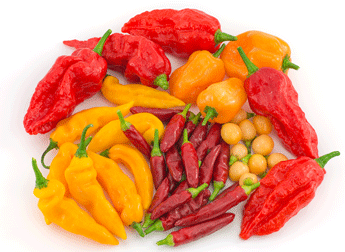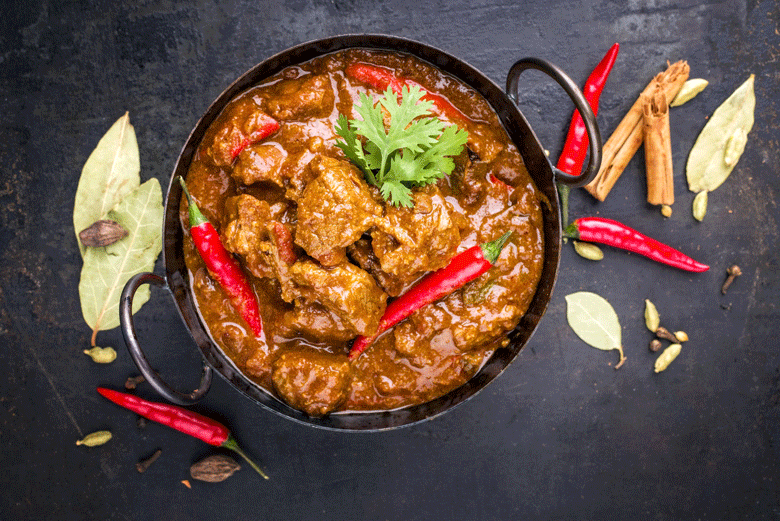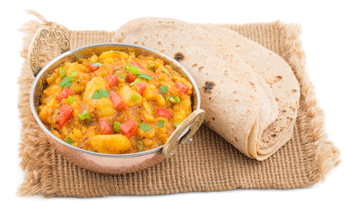
Many people are surprised to learn that before the Chilli being introduced to India by the Portuguese, towards the end of the 15th century, Indian chefs used other spices to provide heat to their cuisine.
Pippali (Piper longum) also known as Indian long pepper, was the main spice used to provide pungency to curries (and to a lesser extent black pepper). Pippali is a flowering vine cultivated for its hot fruit, which, when dried, has a similar but more pungent taste than the ordinary black pepper we know (piper negrum).
 It should come as no surprise that the Chilli became so popular in India. Unlike the Pippali and black pepper, which require specific climate and soil conditions, the Chilli can be grown virtually anywhere. Poor people who found it difficult to afford these spices soon growing Chillies in their back gardens, and used them to add the wonderful spiciness to their curries that only the Chilli can provide.
It should come as no surprise that the Chilli became so popular in India. Unlike the Pippali and black pepper, which require specific climate and soil conditions, the Chilli can be grown virtually anywhere. Poor people who found it difficult to afford these spices soon growing Chillies in their back gardens, and used them to add the wonderful spiciness to their curries that only the Chilli can provide.
Although it was initially specific to one part of India – mainly where the Portuguese traders operated - it soon spread either by nature in migrating birds or from hand to hand throughout India, where it is now not only ubiquitous, but also virtually indispensable in Indian cooking.
Today, India is one of the world’s largest Chilli producers, with an estimated annual production of 1.3 to 1.5 million tonnes. Up to eighty percent is consumed in its domestic market, and the rest is exported

The ways in which Chilies are used
The Chilli is undoubtedly at the top of the list when it comes to spices in Indian cuisine. They are used extensively as both a spice and a vegetable to make the delicious food that the country is so well-known for.
The following are everyday uses for Chillies in Indian cooking.
Curries
Chillies are combined with various other spices, garlic, ginger and meat or vegetables to make a wide variety of gravy based curries. These recipes for these and spice blends used to make them are often closely kept secrets that get passed from generation to generation.
 Being a mainly vegetarian country means many curries are made with vegetables, cheese, beans, eggs, rice and Soya protein. Curries that fall into this category include Aloo ( potato ) curry, Kadai Paneer ( cheese based curry), Biryani ( rice curry) and egg curry. Soya bean protein curries are popular, as are curries made with chickpeas like
Being a mainly vegetarian country means many curries are made with vegetables, cheese, beans, eggs, rice and Soya protein. Curries that fall into this category include Aloo ( potato ) curry, Kadai Paneer ( cheese based curry), Biryani ( rice curry) and egg curry. Soya bean protein curries are popular, as are curries made with chickpeas like
Non-vegetarian choices include curries made with chicken, seafood and meat. Many curries are made with lamb, including Lamb Vepadu (Stir fried curry) and Lamb Keema (spicy lamb mince). Chicken is also used extensively to make curries like Shahi murgh korma (a creamy curry with almonds), Vindaloo (hot and spicy curry) and Mansa Takari (lamb curry from Odisha). Fish, crab, prawn and shellfish curries are also popular
Bread
Breads are made with various flours, including Gram, Maize, Millet, Wheat flour etc. Chillies are an ingredient in making many flatbreads and crepes, including Methi paratha (flatbread with fenugreek and Chillies), Sindhi Koki (roti with Chillies, spices and pomegranate seeds, and Pudla (crepe made with chickpea flour and chillies)
Pickles
A wide selection of Pickles are made with Chillies, either by simple pickling them whole in vinegar, fermentation or mixing them with vegetables or fruit. Mango achar is an example of where Chillies and fruit are combined in pickles. An example of a typical Indian pickle made with Chillies can be found here
Chutneys and relishes
Indian chefs make some delicious chutneys from fruit, vegetables, and even meat. Chillies are nearly always an ingredient in Chutneys, like Gonguru pachadi (Gonguru leaf, onion and chillies), Tamatar Ki Chutney (Tomato chutney), Ulli Pachadi (onion chutney) and Mango chutney
Powders, flakes and spice mixes
Curry powders are made using Chilli powders , Chilli flakes are also widely used in seasoning food
Hot sauces
Many hot sauces are made to be served with curries, flatbreads and eggs. Hot sauces that are typically Indian include Green Chilli sauce, Bhut Jolokia sauce and red Chilli sauce
These are just the start of how Chillies are used in Indian cooking. Other uses include making drinks with Chillies, making snacks and simply eating them raw to spice up a dish.
There are literally thousands of Chilli varieties that may be used in Indian cooking, but many may be difficult to find or simply unobtainable. Our list aims to provide a good selection of Chillies that are reasonably easy to get hold of and will cover, not all, but many of the more common uses of the Chilli in Indian cuisine.
The Kashmiri Chilli - is a Chili that is normally found in dried pods and used in many curries for the bright red colour it imparts. It is not particularly hot with a Scoville rating of approximately 2000 SHU. Hydrates when cooked in a curry.
Birds Eye Chilli (Dhani) – is a very hot Chill that provides pungency to curries. Also used in pickles and chutneys.
Bhut Jolokia - Super hot Chilli that must be treated with caution. Can be used in curries and hot sauces.
Green Finger Chillies (Hari Mirch) - Can be used for making sambals (a hot relish made with vegetables or fruit) for serving with curry or eaten with poppadoms. Can be used to make pickles and relishes. Also used in curries.
An interesting Chilli from India that is not that well-known is the Kanthari Malaku (an ivory coloured Chilli from Kerala). This Chili is used mainly to make pickles and chutneys. Other chillies used in Indian cooking are the Mathania , Longi, Gundu, Reshampatti, Jwala and Naga Chillies (plus a lot more).
Read More: More recipes from India
